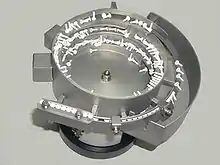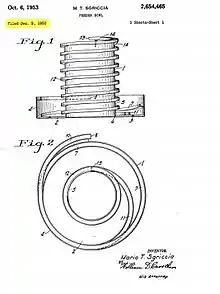Bowl feeder
Vibratory bowl feeders are common devices used to feed individual component parts for assembly on industrial production lines. They are used when a randomly sorted bulk package of small components must be fed into another machine one-by-one, oriented in a particular direction.[1]

Use
Vibratory feeders rely on the mechanical behaviour of a part, such that when gently shaken down a conveyor chute that is shaped to fit the part, they will gradually be shaken so that they are all aligned. They thus leave the feeder's conveyor one-by-one, all in the same orientation. This conveyor then leads directly to the following assembly or packing machine.
Orientation relies on the shape and mechanical behaviour of an object, particular the position of its centre of mass in relation to its centre of volume. It thus works well for parts such as machine screws, with rotational symmetry and a clear asymmetry to one heavy end. It does not work for entirely symmetrical shapes, or where orientation depends on a feature such as colour. The ramps within a bowl feeder are specifically designed for each part, although the core mechanism is re-used across different parts.
The exit orientation of a bowl feeder depends on the part's shape and mass distribution. Where this is not the orientation needed for the following assembly step, a feeder is often followed by a twisted conveyor that turns the part over, as needed.
With increasing integration across an entire production process, the need for feeders is sometimes reduced by supplying the components on tape packages or similar, that keep them oriented the same way during shipping and storage. These are most common in fields such as electronics, where components must be used in a particular orientation, but this cannot be detected mechanically.
Vibratory feeders, commonly known as a bowl feeder, are self-contained devices, consisting of a specially shaped bowl designed to orient the parts to a specific orientation. A vibrating drive unit, upon which the bowl is mounted and a variable-amplitude control box controls the bowl feeder. Usually included is an out feed accumulation track (linear or gravity) to convey parts along and discharge into the assembly machine comes in many shapes and sizes. The drive unit, available in piezoelectric, electromagnetic and pneumatic drives, vibrates the bowl, forcing the parts to move up a circular, inclined track. The tooling (hand made) is designed to sort and orient the parts in to a consistent, repeatable position. The track length, width, and depth are carefully chosen to suit each application, component shape and size. Special bowl and track coatings are applied according to shape size and material of the component which aids traction, damage to the product and lower acoustic levels. A variable speed control box is used for controlling the vibration speed of the bowl feeder, and can control the flow of parts to the out feed track via sensors.
Vibratory feeders are utilized by all industries, including the pharmaceutical, automotive, electronic, cosmetic, food, fast moving consumable goods (FMCG), packaging and metalworking industries. It also serves other industries such as glass, foundry, steel, construction, recycling, pulp and paper, and plastics. Vibratory feeders offer a cost-effective alternative to manual labour, saving manufacturer’s time and labour costs. Several factors must be considered when selecting a parts feeder, including the industry, application, material properties and product volume.
History/inventor
- Feeder Bowl: 12/09/1950, US patent 2,654,465, Mario Thomas Sgriccia[2]
- US Patent: https://docs.google.com/viewer?url=patentimages.storage.googleapis.com/pdfs/US2654465.pdf
- See image.
 Feeder bowl image from 1950 US patent 2,654,465
Feeder bowl image from 1950 US patent 2,654,465
Type of bowls
| Bowl | Material | Suitable for |
|---|---|---|
| Cylindrical bowl | Aluminium/stainless steel | Continuous transport of components and for handling small parts |
| Conical bowl | Aluminium/stainless steel | Heavy sharp-edged components
Larger loads Automatic pre-separating |
| Stepped bowl | Aluminium/stainless steel | Larger loads and larger components
See also conical bowls |
| Polyamide bowl (conical or stepped) | Small components with simple geometry and where mass production of feeders is required |
Types of feeding systems
- Bowl feeders: consist of a bowl top with a spiral track inside the bowl. The component parts are delivered from the bottom of the bowl feeder up the track into the top of the feeder as the bowl vibrates. The parts are then positioned in the proper position. These parts are usually then fed on to a vibratory or air track[4]
- Centrifugal feeders: also referred to as "rotary feeders", have a conical central driven rotor surrounded by a circular bowl wall. The feeder separate component parts utilizing rotary force and the parts revolve with high speed and are pulled to the outside of the bowl.[5]
- Step feeders: The component parts are collected from the hopper by elevating plates, pre-sorted and fed until they reach the desired transfer height. Key features of step feeder are that it operates quietly and without vibration.
- Linear feeders: Horizontal conveying of components. Used to handle irregular supplies of parts from upstream equipment, creating a buffer store and smooth flow for further processes. Special application: multi-track design.[6]
- Carpet feeders: Enable gentle handling of orientated components from bulk to escapement devices creating product accumulation prior to a machine or handling unit.[7]
- 3-Axis Vibration feeders: Robotic parts feeders using a vibratory plate to distribute parts evenly on a level surface for pickup by an industrial robot. This type of feeder allows very high performance flexible part feeding, part pre-orientation and optimal surface distribution of bulk parts and components.[8]
- Space feeders: Space feeder is used for separating and feeding loose film bags, four-sided sealing bags, flow packs, 3D bags and so on. This type of feeder is versatile high speed units with the ability to isolate and equally pitch non-uniform and flexible components.[9]
Feeder system companies
- PULSA Bols Vibrants [11]
- TISEC Automation: Industrial Automation Systems Provider[12]
- Autofeed Corporation: manufacturer
- CentriVibe, Inc.: spring separating & feeding systems
- Feed Rite Automation Inc.[13]
- Feeding Concepts, Inc.: machining manufacturing
- FMB GmbH: German manufacturer[14]
- Hoosier Feeder Company: machining manufacturing
- Moorfeed Corporation: manufacturer
- Performance Feeders: manufacturer
- Quantum Feeder Systems Inc.
- R-Tech Feeders: manufacturer, machining, fabrication
- Riley Automation: British manufacturer[15]
- Stromag: manufacturer
- (Shenzhen) Sunitop International Co., Ltd: manufacturer, Sinfonia distributor in China
- Suzhou Huilide Machine Co., Ltd.: manufacturer
- US Automation
- VTR Feeder Solutions: machining manufacturing
- Wibramet Piotr Sokołowski: Polish manufacturer[16]
Accessories
- Coating: Bowl feeder coatings, such as polyurethane or flocking, minimize wear and tear, noise, and damage to parts.[17]
- Sound enclosure/cover: A foam-lined structure that absorbs the noise created by the vibratory feeder. Reduces noise and protects against dust and contamination.
- Base plates: Enable easy mounting of the drive unit to the machine bed
- Sensors: Minimum/maximum level control on a linear track
- Hopper: Large, bulk container that stores material and regulates parts flow into the vibratory feeder system
References
- Maul, Gary (21 August 2008). "A systems model and simulation of the vibratory bowl feeder". Journal of Manufacturing Systems. 16 (5): 309–314. doi:10.1016/S0278-6125(97)88461-0.
- Sgriccia, Mario T. Feeder Bowl. Syntron Co, assignee. Patent US2654465 A. 9 Dec. 1950. Print.
- "Vibratory Bowl Feeder Types" (PDF). Retrieved 5 May 2015.
- "What is a bowl feeder? How does it work?". Retrieved 5 May 2016.
- Eshelman, Michael (New Port Richey, FL), Harrison, George (Brooksville, FL), Roach, Jack (Wrightsville, PA), Roberts, Chad (Spring Hill, FL), Karp, Brian (Spring Hill, FL), Pugh, David (Brooksville, FL), Coombs, Sean (Lansing, MI). 1999. Centrifugal feeder. United States Sims Machine & Controls, Inc. (Brooksville, FL), 5954185, http://www.freepatentsonline.com/5954185.html
- Hoppmann, Kurt H. (Falls Church, VA), Vaughn, Charles (Stafford, VA), Anderson, Philip S. (Sumerduck, VA), Schmitt, Werner H. (Falls Church, VA). 1993. Linear feeder. United States Hoppmann Corporation (Chantilly, VA), 5236077, http://www.freepatentsonline.com/5236077.html
- "Carpet Feeders Features". Retrieved 5 May 2016.
- "Flexible 3-Axis Vibration Feeders". Retrieved 1 May 2016.
- "Space Feeders". Retrieved 1 October 2019.
- "Mechanics of Vibratory Equipment". 3 March 2013.
- http://www.pulsafrance.com/bol-vibrant
- "Automation components manufacturer". Retrieved 31 July 2018.
- http://www.feedriteauotmation.com
- "German Manufacturer".
- "British Manufacturer". Retrieved 5 February 2020.
- "Polish manufacturer of Vibratory feeders". Retrieved 31 July 2018.
- "Coating of vibratory feeders". Retrieved 31 July 2018.
- "Industrial vibrators and bowl feeders". Retrieved 9 September 2018.</ref>